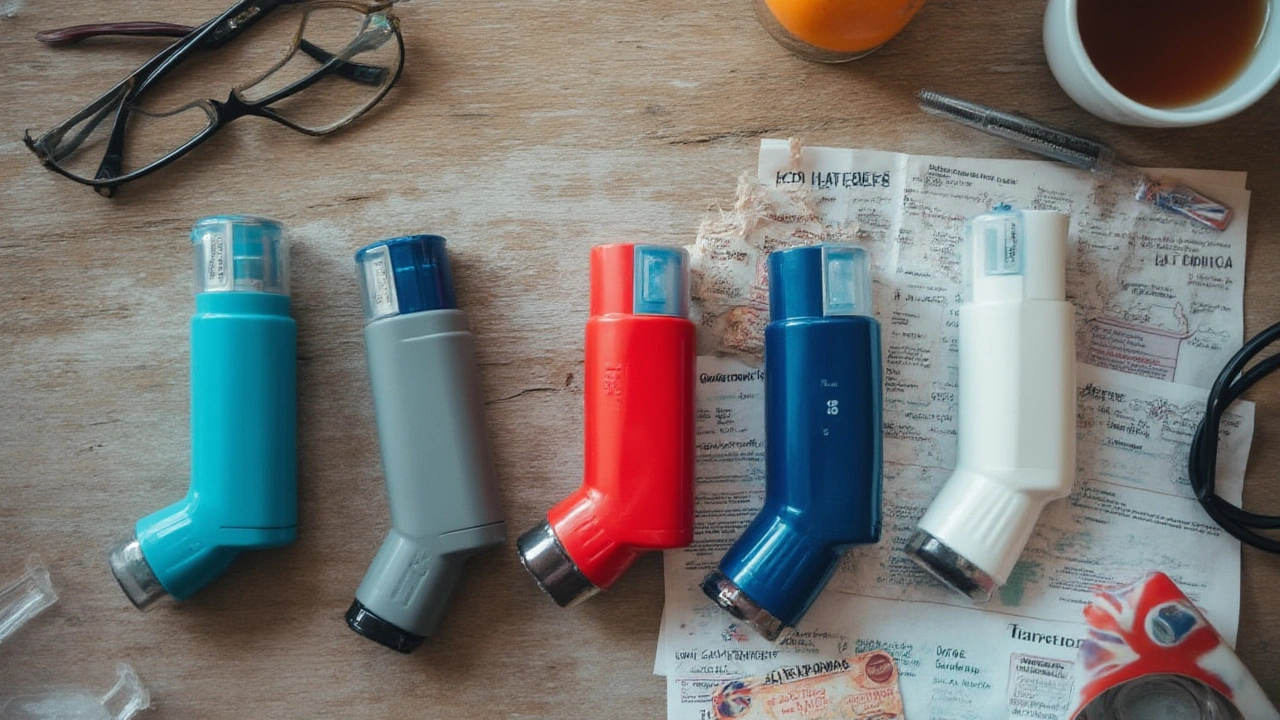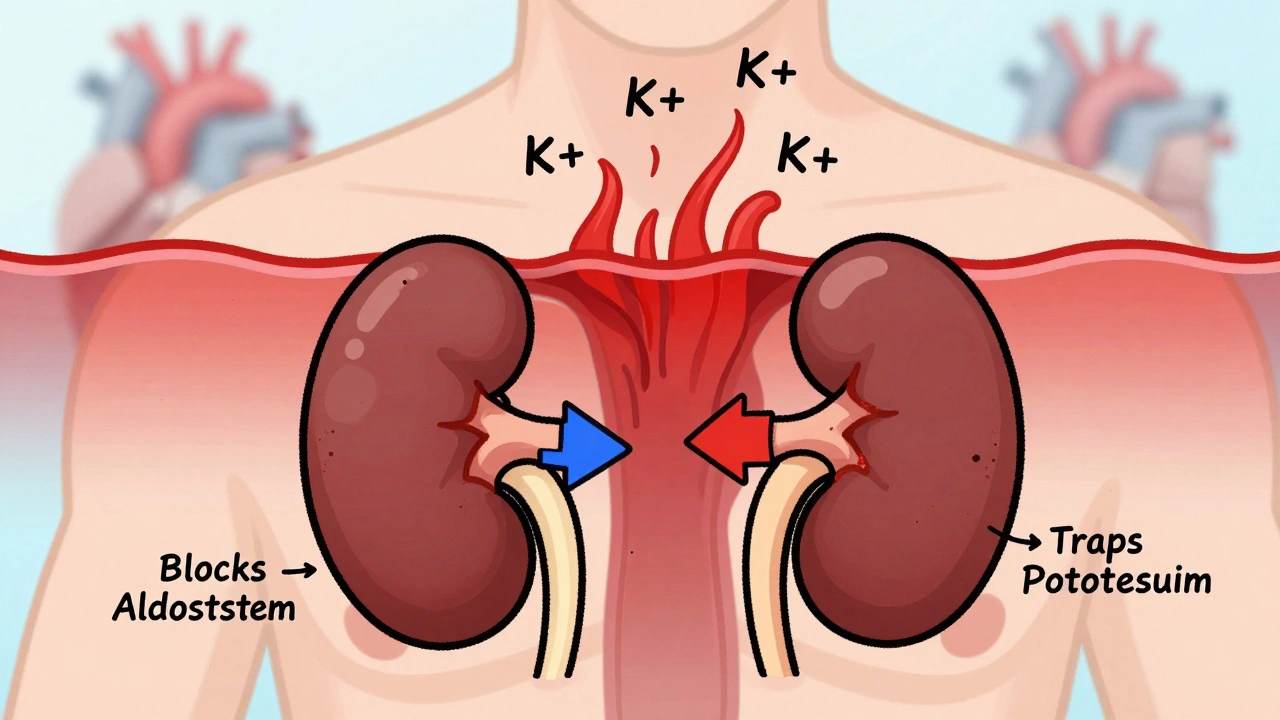If you’ve ever cracked open an inhaler box and wondered, “Is this really the best I can do for my breathing?”—you’re definitely not alone. People living with asthma or COPD in Australia (and pretty much everywhere else) get handed treatment plans full of tricky meds, usually starting with one of those dual-action inhalers like Symbicort. Trouble is, it’s not always the magic fix it’s made out to be—and there are real reasons to look under the hood at what else is out there, especially when your days are still interrupted by wheezing, tight chests, or side effects. The market for combo inhalers (those that mix a long-acting beta-agonist—a “LABA”—with a steroid) isn’t small, but not all combos are created equal.
The Basics of Long-Acting Beta-Agonists and Steroid Combos
First, let’s crack the code: combination inhalers like Symbicort mix a LABA (formoterol in this case) with an inhaled corticosteroid (budesonide). LABAs work by relaxing the muscles around your airways, helping keep them open for a longer stretch of time. The steroid part does the grunt work of calming inflammation inside those airways, so they aren’t firing off alarm bells every time you breathe in some dust or cold air.
Formoterol stands out from other LABAs because it kicks in fast—sometimes in under five minutes—and lasts up to 12 hours. Compare that to salmeterol, which also lasts a long time, but often takes a bit longer to get going. Why pair it with a steroid? No one wants steroids floating through their whole body if they can help it, and inhaling them means they act exactly where you need them: right inside your lungs. This mixing of LABA and steroid isn’t about giving you more drugs for the sake of it; it’s about hacking the system—tamping down inflammation so your airways behave and keeping the bronchi relaxed so every breath feels a bit easier.
But Symbicort isn’t the only show in town. There are other combos with different LABA-steroid pairings: salmeterol/fluticasone (Seretide), vilanterol/fluticasone furoate (Breo Ellipta), indacaterol/glycopyrronium/mometasone (Trimbow), and more. Each option juggles things like speed of onset, length of action, dosing frequency, and side-effect profiles—plus, everyone’s lungs react a bit differently. Which means if you’re not happy with your current combo, tweaking the ingredients or switching formulas is a legit conversation with your doctor.
Why People Look Beyond Symbicort
If Symbicort works for you, nothing wrong with sticking to it, but not everyone gets textbook results. Adherence is a big deal. Studies from Australian hospitals in 2023 showed nearly 41% of asthma patients either used their combo inhalers inconsistently or struggled with technique. Mess up your inhaler use—dose too late, too early, or skip altogether—and those well-tuned ingredients won’t work properly.
Also, some experience side effects: oral thrush (thanks, steroids), hoarse voice, or sometimes the jittery, heart-racing feeling from the LABA bit. Sometimes the combo just isn’t a good fit. More than a few folks need stronger anti-inflammatory action or a longer gap between doses. If you’ve been troubleshooting with your doctor and symptoms are still a nuisance, it might be worth a look at alternative combos, single agents, or even different steroid strengths. The move to an alternative could cut down on side effects, simplify your daily routine, or deliver steadier lung control.
Alternative Formoterol Combos and Their Performance
Formoterol as a LABA isn’t exclusive to Symbicort. There’s DuoResp Spiromax (budesonide/formoterol, just like Symbicort but a different device), Fostair (beclometasone/formoterol), and single-ingredient options where your doctor pairs a formoterol inhaler with a separate steroid inhaler. In head-to-head trials, Fostair has shown similar improvements in lung function and symptom control to Symbicort, but the different inhaler device (a fine mist versus dry powder) can really matter if your technique is off or you have coordination issues.
The three-in-one option (Trimbow: beclometasone, formoterol, glycopyrronium) adds a “LAMA” (another bronchodilator) into the mix, mostly for COPD folks with more stubborn symptoms. In 2024, a multicenter trial across NSW showed Trimbow users had a 24% reduction in COPD exacerbations versus those on steroid-LABA combos alone, though with a slight uptick in mouth dryness and rare palpitations.
What about those not happy with formoterol? The next common move is fluticasone/salmeterol (Seretide). This combo has a bit slower onset, but many report fewer tremors or heart palpitations. Then there’s Breo Ellipta, which is dosed just once daily and is becoming popular for its “set and forget” appeal, especially for forgetful types or anyone who hates hauling an inhaler everywhere. Australia’s PBS data showed steady growth in Breo prescriptions in Sydney in 2024, mostly among working adults who prefer the simplicity of morning-only dosing.
Here’s a quick comparison of some common combos for asthma and COPD:
| Inhaler | LABA | Steroid | Main Benefit | Dosing |
|---|---|---|---|---|
| Symbicort | Formoterol | Budesonide | Quick onset | 1–2x/day |
| Seretide | Salmeterol | Fluticasone | Good for steady-state control | 2x/day |
| Breo Ellipta | Vilanterol | Fluticasone furoate | Once-daily, simple | 1x/day |
| Fostair | Formoterol | Beclomethasone | Fine mist; easy inhalation | 2x/day |
| Trimbow | Formoterol | Beclomethasone + Glycopyrronium | Triple action for stubborn COPD | 2x/day |
For a deep dive into newer formoterol alternatives, there are some up-and-coming combos being trialled, plus tweaks in inhaler technology (including “smart” devices that monitor adherence) just breaking onto the market. But for most Aussies, those main combos above are the core of real-world daily management.

When Alternative Combos Outperform Symbicort
Let’s get specific: in what situations do these alternatives actually leave Symbicort in the dust? For one, if you’re someone who only gets relief from a very low or high steroid dose, alternatives let you fine-tune things better. Seretide and Fostair both offer a range of strengths, sometimes making it easier to match your personal sweet spot. If Symbicort triggers ongoing throat issues or causes palpitations, a different LABA (like salmeterol) might help you dodge those, even if your doctor has to trade off a slightly slower onset.
For hard-to-control asthma— the kind that flares up every time you hit pollen season—trials out of Westmead Hospital in 2024 found that some patients did dramatically better with once-daily Breo Ellipta, mainly because they just didn’t miss doses. (Bonus: fewer missed days at work or hospital trips.) For elderly patients, a device like Fostair’s soft mist is just plain easier, especially if you struggle to inhale as strongly as these dry powder inhalers require.
Triple therapy (Trimbow) basically rewrites the playbook for COPD: one big Sydney study showed a 30% reduction in severe flare-ups over 12 months compared to regular combo inhalers, so anyone with frequent hospital visits or severe breathlessness should ask about it. Even in Australia’s regional towns, more GPs are shifting hard-to-manage cases to triple combos to break that cycle of relapses and steroid bursts.
Ultimately, if your daily life is still being shaped by asthma or COPD—even while on Symbicort—don’t settle. There are strong reasons to look at alternatives, tweak dosages, or try a new delivery method. Not all lungs (or lifestyles) are the same, and one-size-fits-all isn’t a thing with chronic lung disease.
Practical Considerations: Devices, Dosing, and Side Effects
Even the world’s best formula isn’t going to help much if you can’t use the inhaler properly. Device design matters. Anyone who’s had that panicky moment of wondering whether their puff even went in knows what I’m talking about. Dry powder inhalers (like Symbicort and Seretide in Turbuhaler or Diskus form) reward a good, hard suck, which is easier when you’re young and have solid lung power. But if you’re old, frail, or in a flare, a pressurized metered dose inhaler (like Fostair or Flutiform) with a spacer is easier and less likely to be wasted on your tongue.
Let’s talk side effects. LABAs can cause a racing heart, trembling hands, or even some unwanted anxiety if you’re sensitive. The steroids do help with inflammation, but they can rough up your voice or make you more likely to get oral thrush—especially if you don’t rinse your mouth after a puff. In rare cases, inhaled steroids can affect bone density or slow growth in kids, but that risk is pretty low at common doses, especially compared to the havoc of poorly-controlled asthma or COPD on your body.
- Good tip: Always rinse your mouth after using a steroid inhaler.
- Check your inhalation technique every couple of months—your GP or pharmacist can do this.
- If your inhaler feels awkward or you’re not seeing results, ask for a demo with a different device. Not every GP will push for this, so speak up.
- If you’re skipping doses because of inconvenience, side effects, or just forgetting, explore once-daily or even smart inhalers that give reminders.
Cost is often in the mix. Thanks to the PBS, most combos in Australia are on a roughly even playing field out-of-pocket, but check the pharmacist’s best price, especially for newer options that might not be fully covered or stocked in rural areas yet. Many employers and public health clinics are now giving out inhaler spacers for free—grab ‘em if you’re eligible.
Finding Your Best Combo: Real-Life Tips and Next Steps
Here’s the real story: no matter what statistics or charts say, your “perfect” inhaler will depend on your lung quirks and lifestyle. If you’re the type who hates morning routines, once-daily Breo or a triple combo could make the difference. If you struggle with dry mouth or find the powdery taste unbearable, those metered-dose mist inhalers might work better. If price, side effects, or convenience are still headaches, it’s worth keeping that discussion going.
Asthma and COPD are both super personal. What works for your mate at footy won’t always be your fix. Lung function tests (spirometry), symptom diaries, and regular check-ins—these make it possible to spot when it’s time to swap up your combo. There are patient forums, asthma educators, and specialist clinics all through Sydney and beyond that don’t just push the same-old, same-old. It’s never too embarrassing to bring a list of questions to your next GP visit, either. It saves you the “back and forth” and gets solutions on the table faster.
The real win isn’t finding the “best” option off some chart, but landing the one that lets you feel like yourself again – going to the beach, hitting work, or sleeping all night without coughing fits. There are a lot of choices, so don’t be shy about swapping or sticking up for what feels right. If you want to know what’s newer or just coming to Australia, there’s a lot more info on different formoterol alternatives online, so it’s not a one-horse race. And with pharmacists and GPs so used to seeing these questions, you’re definitely not winging it alone.







RUCHIKA SHAH
July 29, 2025 AT 21:22Finding the right inhaler feels like a personal journey.
Justin Channell
August 8, 2025 AT 03:36Great rundown on the options 😊 It’s good to know there are alternatives if Symbicort isn’t clicking for you. A simple switch can sometimes ease side‑effects and improve adherence. Keep an eye on the device style that matches your breathing pattern 🙌 Stay positive and keep tracking how you feel.
Basu Dev
August 17, 2025 AT 09:49The choice of a LABA‑ICS combination goes beyond just the active ingredients; it also hinges on the inhaler device mechanics and patient technique. Many patients underestimate how a subtle change in inhalation flow can alter drug deposition in the lungs. For instance, dry powder inhalers demand a rapid, deep inhalation, whereas metered‑dose inhalers rely on a coordinated actuation‑and‑breath sequence. When the technique is inconsistent, the pharmacologic benefit diminishes, leading to persistent symptoms despite what appears to be optimal therapy. Studies from Australian respiratory clinics have shown that up to forty‑one percent of users demonstrate suboptimal technique at routine checks. This figure rises further among elderly patients who may have reduced inspiratory force or comorbidities affecting hand‑mouth coordination. Regular inhaler training sessions, ideally every six months, can correct these errors and sustain clinical control. Moreover, the dose‑strength flexibility offered by various combos, such as low‑dose beclomethasone with formoterol versus higher‑dose budesonide, allows clinicians to tailor anti‑inflammatory potency without escalating systemic exposure. The addition of a LAMA in triple therapy, as seen with Trimbow, provides bronchodilation through a different pathway, which can be crucial for COPD patients with frequent exacerbations. However, this added component may increase the risk of dry mouth and occasional palpitations, necessitating patient counselling. It is also worth noting that once‑daily options like Breo Ellipta improve adherence simply by reducing the cognitive load of remembering multiple daily doses. Yet, the once‑daily formulation may not suit patients who require rapid symptom relief during acute flare‑ups, where a faster‑onset LABA such as formoterol might be preferable. Cost considerations remain relevant; while PBS subsidies level the playing field for many combos, newer devices may have limited stock in rural pharmacies, leading to delays. Finally, integrating smart inhaler technology that records actuation timestamps can provide objective adherence data to inform shared decision‑making. In summary, a holistic assessment that includes device choice, technique reinforcement, dose flexibility, and patient lifestyle yields the best chance of outperforming a one‑size‑fits‑all approach.
Krysta Howard
August 26, 2025 AT 16:02While the overview is thorough, it glosses over the real‑world drawbacks of some combos, especially the increased risk of oral thrush with high‑dose steroids. Patients need clear guidance on rinsing after each use, and clinicians must balance potency with tolerability. Ignoring these side effects can lead to non‑adherence, which defeats the purpose of any regimen.
Elizabeth Post
September 4, 2025 AT 22:16Good points about device selection – many people don’t realize that a soft‑mist inhaler can be a game‑changer for those with weaker inhalation force.
Brandon Phipps
September 14, 2025 AT 04:29I’ve seen firsthand how the inhaler’s design influences daily outcomes; when a patient struggles with the dry‑powder resistance, they often end up under‑dosing without even knowing it. In my practice, we encourage a trial of both a dry‑powder and a metered‑dose inhaler during the initial assessment to see which feels more natural. This hands‑on approach not only improves technique but also boosts confidence, leading to better symptom control. Additionally, reviewing the spacer options can make a huge difference for those with coordination issues, as the spacer slows down the aerosol and reduces oropharyngeal deposition. It’s also worth mentioning that many patients appreciate once‑daily regimens simply because they fit better into a busy lifestyle, and adherence data consistently show higher compliance rates with fewer daily doses. However, we must remain vigilant about potential trade‑offs, such as slightly slower onset of action with some once‑daily LABAs. Ultimately, the goal is to match the inhaler’s pharmacology with the patient’s habits, physical abilities, and preferences, creating a truly individualized therapy plan.
yogesh Bhati
September 23, 2025 AT 10:42Yo dude, i thinky u should try a softer mist inhaler like Fostair it feels more easy to use thn the powde ones they all be hard to puff.
Akinde Tope Henry
October 2, 2025 AT 16:56Australia’s guidelines are solid but local doctors must adapt them to our own patient pool.
Brian Latham
October 11, 2025 AT 23:09Honestly this post is a bit over‑the‑top – not everyone needs a PhD to pick an inhaler.
Barbara Todd
October 21, 2025 AT 05:22I’m curious how many patients actually switch after the first side‑effect appears rather than enduring it.
nica torres
October 30, 2025 AT 10:36Love the emphasis on trying different devices – keep experimenting until you find the one that makes you feel unstoppable! 🌟
Dean Marrinan
November 8, 2025 AT 16:49Oh sure, because we all have unlimited time to test every inhaler on the market 😂. Maybe next you’ll suggest we all become pulmonologists too? 🤷♂️
Oluseyi Anani
November 17, 2025 AT 23:02From a broader perspective the key is to view inhaler choice as part of an integrated care plan that includes lifestyle, environment, and even nutrition, not just a pharmacologic decision.
Jeremy Wolfe
November 27, 2025 AT 05:16You’ve got the data, now act on it – schedule that inhaler check‑up, discuss alternatives with your doctor, and don’t settle for lingering symptoms.
Rahul yadav
December 6, 2025 AT 11:29It’s heartbreaking watching someone struggle for breath because the inhaler just isn’t right for them 😢. Let’s champion personalized combos and give every patient a chance to breathe freely! 🌬️💪
Dan McHugh
December 15, 2025 AT 17:42Some of the details feel redundant; a concise table would have sufficed.
Sam Moss
December 24, 2025 AT 23:56Picture this: you’re at the beach, waves lapping, and your lungs are as calm as the sea because you finally nailed the perfect inhaler combo – that’s the freedom we’re hunting.